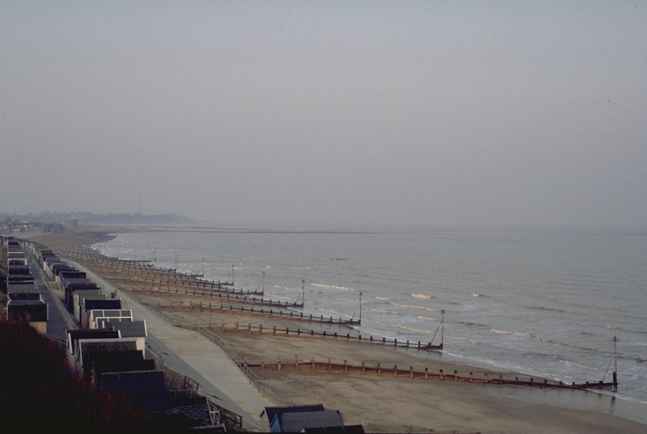Dummoc (original) (raw)
![]()

Quite possibly, this Minster never existed. And if it did, it might have existed somewhere else. All we really know is that, according to St Bede in his History of the English Church, East Anglia's first Bishop, St Felix, established his See at a place called Dummoc or Dumnoc. Popular Suffolk mythology places this at the now-submerged settlement of Dunwich; but really, there is no evidence for this, beyond the similarity in the name, and the romance of a lost city.
Dunwich is the most famous, but Suffolk actually has a dozen or more settlements that have been lost to the sea over the last couple of millennia. Walton Castle is one of them. It is named for the adjacent parish of Walton, but is actually closer to the modern town of Felixstowe, which has grown up in the intervening 2000 years. The Castle was actually a sea fort, built by the occupying Roman army to defend their colony against the attacks of itinerant bands of Germanic and Scandinavian pirates. Walton Castle was placed strategically at the mouths of the Rivers Deben, Orwell and Stour, all of which come out here. Today, it lies about half a mile out under the sea, but is visible from the beach at Old Felixstowe at very low tides, as in the picture taken by Dr Sam Newton at the top of the page. You can see a bit of wall poking above the waves in the centre of the picture.
Other sea forts survive in much better condition. Once in Suffolk, but now over the border in modern Norfolk, is Burgh Castle, where St Fursey established his mission to the heathen English in the years after the Romans abandoned Britain. To the south is Bradwell, where St Cedd's Minster actually survives in more or less complete form. Again, an abandoned sea fort must have seemed a good place to establish a monastery. And so, a pattern begins to emerge.
The English Kingdom of East Anglia was ruled by the Wuffing family, one of whom, Redwald, was probably the subject of the great ship burial at Sutton Hoo. Redwald's son, Sigebert, converted to Christianity (as, in fact, Redwald had, but he was careful to keep an iron in both fires). in 631, Sigebert invited the Burgundian missionary Felix to establish the Holy Catholic Church in East Anglia. Although Walton may seem geographically remote from the East Anglian capital at Rendlesham, in fact, it wasn't. The mouths of the three rivers were host to a conglomeration of communities and ports, nearly all of which are now lost to us; among them were Brackenbury and the Kingshaven at the mouth of the Deben, and Stratton and Grimston around the corner on the Orwell. The first two are lost to the sea; the second two still survive in names of farms, and the sites of their medieval churches are known. Walton Castle is barely seven miles by boat down the Deben from the Royal burial ground at Sutton, barely ten overland from Rendlesham across the Deben peninsula.
It seems far more likely that Felix would establish his minster in an abandoned Roman fortification near to the capital than in an unpeopled estuary twenty miles further up the coast, for there is no evidence that Dunwich was anything other than this before the early Middle Ages.
And there is more evidence, that strengthens the case for Dummoc being Walton Castle. Dr Sam Newton points out that there appears to have been a church dedicated to St Felix within the castle walls in the 12th century, when it was granted to Rochester Priory by the Bigod family. St Felix is a very unusual dedication for a medieval church in East Anglia, so there may have been some reason for it. Further, Dr Newton argues that some field names in the area are also suggestive of this being Felix's Dummoc. The case is not proved, but the evidence is compelling.
Felix didn't stay long in the area; soon, the East Anglian See was moved to Elmham in Norfolk, and then to Thetford, and after a failed attempt to establish it at Bury St Edmunds it moved to Norwich. The restored Bishop of East Anglia still has his Cathedral at Norwich, the massive pile of St John the Baptist on the Unthank Road, the work of Sir George Gilbert Scott. And the Anglicans, who inherited the medival Norwich Cathedral at the Reformation, have their Bishop of Norwich too.
Perhaps more interesting than Walton Castle being Dummoc is that this would mean that Dunwich isn't. Both the Catholic and Anglican Bishops, not unnaturally, trace their line back to St Felix, Bishop of Dunwich, and the Suffolk Anglicans even created a new Bishop of Dunwich as suffragan assistant to their Diocesan Bishop of St Edmundsbury and Ipswich, when this Diocese was carved out of Ely and Norwich in 1912. But perhaps there never was a Bishop of Dunwich - certainly, there is no evidence that a minster of any kind was established there, and none of the known Parish churches and chapels of the town were dedicated to St Felix.
The theory is complicated by the fact that Felixstowe is probably not named after St Felix, the name coming from Fylthestow, meaning a place where trees or meadowgrass are harvested. But on balance, I'm convinced. A rich and fascinating picture is beginning to emerge of a lively culture in the 7th century around the mouth of the Deben, and perhaps we shan't need to call them the Dark Ages anymore.
The site of Walton Castle is about half a mile off of Old Felixstowe, and remains can be seen at very low tides.
The best source of information on St Felix and Walton Castle, and on the Wuffings and the Kingdom of East Anglia in general, is Dr Sam Newton's splendid Wuffings website.
Amazon commission helps cover the running costs of this site



